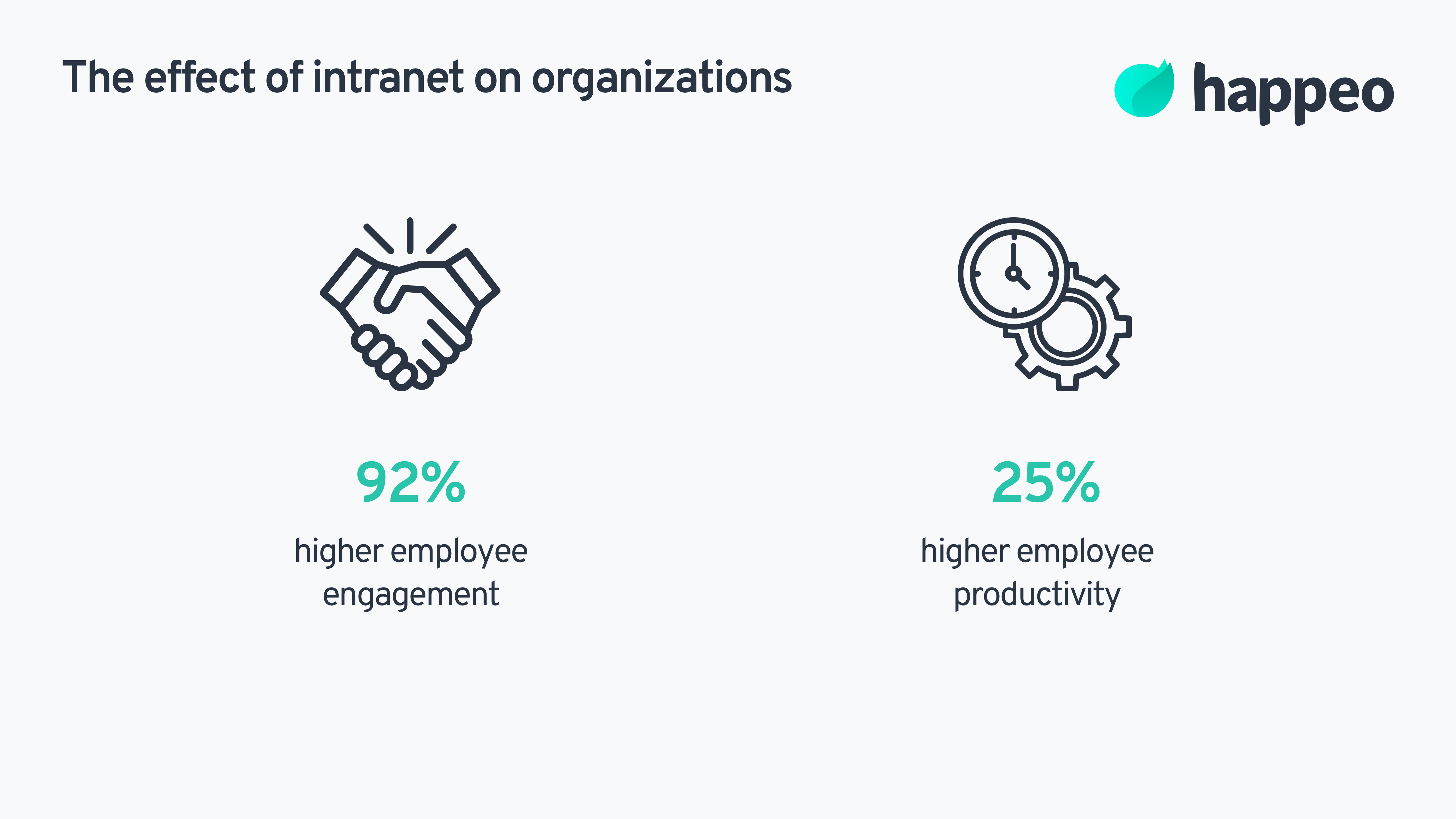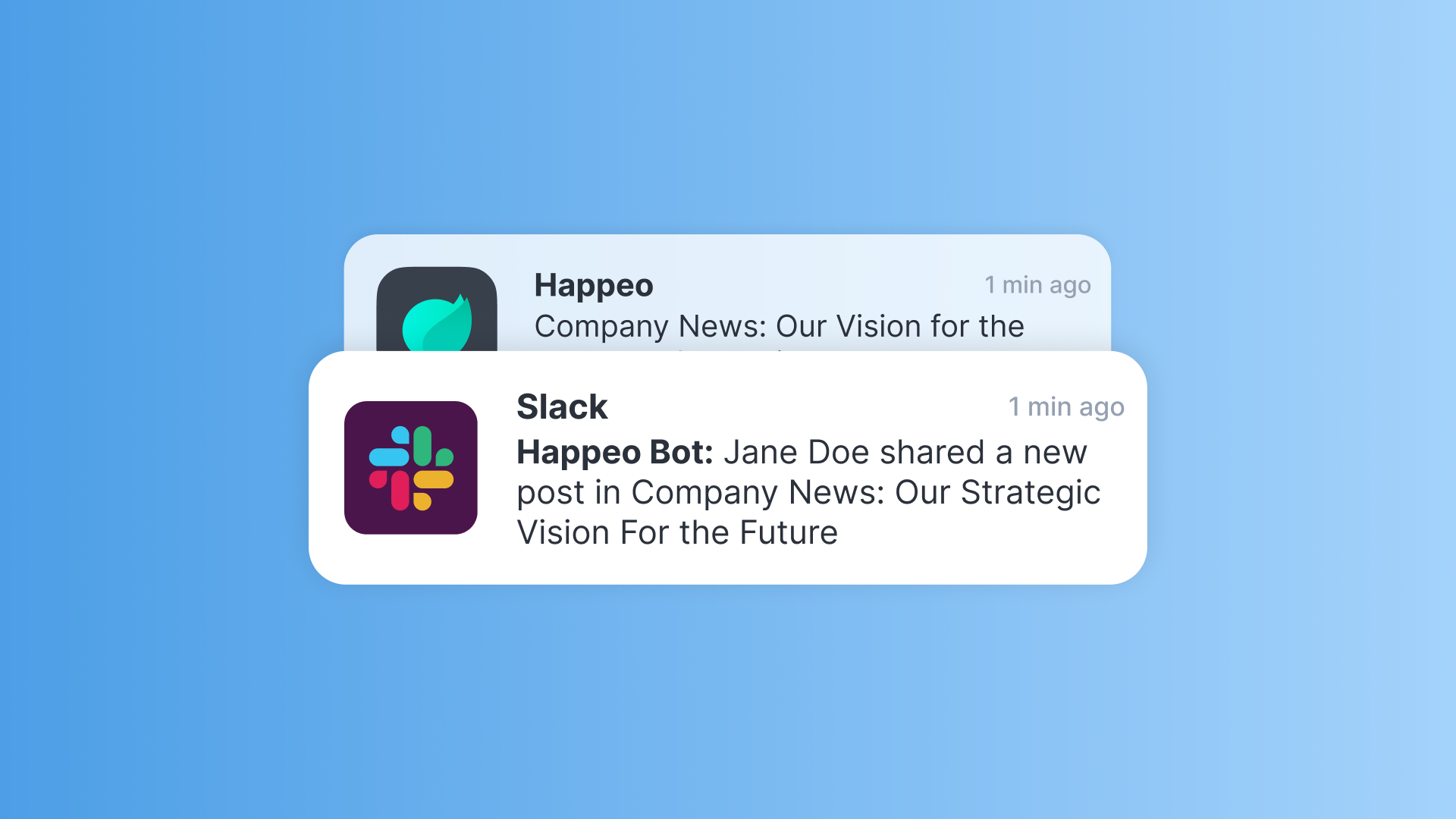
Internal Communications Expert insights
12 useful intranet KPIs your business should analyze in 2024


Jonathan Davies
14 mins read
Start building your digital home with Happeo
Request a demoThere’s so much buzz around the success of intranet solutions, but how can you actually measure this?
The focus of the new digital workspace is all based around improving employee experience, but that is a hard factor to quantify. With a lot of investors, customers, and other important people to report to, you need some hard facts to prove the success of your intranet software performance.
Want to see an intranet in action?
Watch video
The focus of the new digital workspace is all based around improving employee experience, but that is a hard factor to quantify. With a lot of investors, customers, and other important people to report to, you need some hard facts to prove the success of your intranet software performance.
Despite these outside appearances, it is possible - and quite important - to measure and track intranet success. After all, a successfully implemented intranet has the potential to improve employee engagement by up to 92% and workplace productivity by 25%.
So which intranet metrics should you be tracking when it comes to measuring success? We’re going to give you 12 different intranet KPIs that will provide measurable results and ROI figures for your company to use. But first and foremost, what are intranet KPIs and intranet metrics?
What is an intranet KPI?
An intranet KPI (Key Performance Indicator) is a specific outcome your intranet should realize in order to achieve bigger business goals.
What is an intranet metric?
An intranet metric is a measurement you use to track your intranet's activity and effectiveness. For these figures to be valuable or make sense, you will need to have a baseline to work from. Make sure when you perform your intranet needs analysis that you have an idea of your intranet KPIs so you can access the baseline you need to compare against after implementation. This will allow you to measure the increase or decrease in certain values and figures. Read this if you or your coworkers need any convincing on why it's important that Internal Communications measures its performance.
12 KPIs to measure intranet success
1) Employee satisfaction
Although this is the area that seems the most subjective area in measurable intranet KPIs, it is still a great way to measure an intranet platform success when you look for the right kind of figures. Employee satisfaction is important to conclude because this really is the purpose of implementing an intranet platform - to increase productivity by enhancing the employee experience.
How can this be measured?
Basic employee satisfaction surveys dispersed directly to employees will give you results on your intranet performance. Asking questions that will yield answers about intranet content, tools, design, UI, search engine, and overall efficiency can get you data, which you can turn into hard facts.
Example intranet KPIs:
- Employee satisfaction increased by 47% after implementing the new intranet software
- 26% of employees report that company-wide communication has improved
- 4 out of 5 employees say that the new intranet UI is easy to use and navigate
- 45% of employees say it is easier to collaborate with coworkers through new intranet tools.
2) Login numbers and usage time
To prove intranet software success, you need to prove that the system is relevant and frequently used by employees. Tracking how many users are logging in, how frequently they are doing it, and how long they stay connected will give you a solid indication of how engaged your employees are with your intranet software. This can also be tracked for intranet mobile apps as well, and these results will let you know where employees are logging in and working as well.
How can this be measured?
User logins and usage time can be tracked through intranet analytics built into your intranet software, or from an external intranet performance analysis tool, such as Google Analytics, which can be integrated into your system.
Example intranet KPIs:
- 87% of employees log in to the intranet platform daily
- 45% of employees stay logged in for over 5 hours
- Mobile app users log in 4 amount of times per day
- A 37% increase in employee logins since implementation
Engagement and clicks
While tracking logins is a helpful tool, it doesn’t necessarily tell you if the users are actually engaging with the intranet software. They might be logging in, but are they interacting with the interface? This is where tracking number of clicks and comments comes in. Analyzing the number of times each user is clicking on links within your intranet platform - or contributing content - will give you an accurate picture of the engagement and intranet adoption rate of employees, but it will also help measure overall intranet performance through increase in internal communication.
How can this be measured?
- Tracking employees' comments on news, blogs, or other content
- Tracking the “like” or reaction clicks
- Tracking internal tagging of coworkers
- Tracking email or article CTR (click-through rates)
- Tracking users editing and creating content
Example intranet KPIs:
- 11 employees are creating original content on the intranet
- Internal communication and collaboration have increased by 58%
- 78% of users are interacting with the intranet platform for over 5 hours daily
- 4 out of 5 employees are socially engaging with one another on the intranet platform
4) Reduced business costs
Seeing an increase in employee engagement and communications might be an obvious benefit to implementing an intranet, but an increase in productivity usually correlates with a decrease in business costs. There are obvious ways that going digital will save business costs (such as reduced paper, printing, and distributing expenses), but intranet platforms can save money elsewhere too. With increased opportunity for collaboration, there could be a cut in business travel expenses. Cost reductions can be seen in labor efforts as well. By giving employees access to forms digitally, you can cut back on HR overhead costs.
Measuring hours saved by employees can result in a dollar amount if tracked correctly as well. Laurie Brownson, digital transformation program manager for Framatome, explains to CMSWire that in her organization “the metrics are a translation of hours saved (from a pre-established measurement system) into soft or hard dollar savings, which gets reported on a quarterly basis to management.” Look into establishing an analytics system that can create these type of results to generate intranet KPI metrics.
How can this be measured?
- Tracking employee time spent on administrative tasks such as payroll, time management, employee documentation
- Tracking printing costs
- Tracking time spent on installation efforts
- Tracking IT time spent responding to employee concerns
- Tracking travel expense budgets
Example intranet KPIs:
- Printing costs were cut by 18% after intranet implementation
- Time spent by IT attending to employee concerns decreased by 43%
- $390 saved by cutting 20 hours from internal meetings
- Travel expense budget reduced by $50,000 after intranet implementation
Discover all the features of an intranet software
Download list
5) Turnover rates
The employee turnover rate aligns with the theme of employee satisfaction. Intranet platforms are really a system and service to the employees, so if they are functioning well, employees will be pleased and content with their positions. They will feel empowered in the workplace and supported by the company. By tracking your company’s turnover rate, you will gain insight into employee satisfaction and internal communication efficiency. When communication is effective, your employees will feel like they are in the loop and their voice is heard, and they will retain enthusiasm for the company. If they feel lost in the sea of the corporate world, they will most likely lose their job satisfaction and move on.
How can this be measured?
Turnover rates can be tracked through HR records. Try to look for connections between your internal communication KPI results and your turnover rates. Also, look into new hires and their retention rate before and after intranet implementation.
Example intranet KPIs:
- A 14% decrease in turnover rates after intranet implementation
- A 10% employee retention rate after intranet implementation
- A 13% decrease in employees who left the company due to internal communication difficulties
6) Employee reach
With previous intranet software, there were many employees who were unreachable. Think about your remote workers or on-the-go travelers. Those are the employees who probably checked into the intranet software less frequently than others. But by being able to log in from anywhere, paired with mobile app features, your employee reachability is sure to increase. Researching and documenting the number of employees you can now reach through your improved intranet performance can prove intranet software success.
How can this be measured?
By tracking the number of unique visitors using the intranet platform and dividing that by your total number of employees for a specific time period (i.e. one month), you can get your total reach percentage. You can also divide the total number of visits by the number of unique visitors to get the average number of visits per employee. Use this against your baseline of previous user numbers to show an increase in reach.
Example intranet KPIs:
- In the month of May, we had 3,000 out of 4,200 unique visitors to the intranet for a 71% reach.
- 35% more remote workers are logging in daily
- In one week we had 5,000 visits from 50 unique visitors for a total of 100 average visits per employee
- 273 employees are using the mobile app when out of the office
7) Increase in sales
Easy access to information in your sales team will most likely result in an increase in productivity so they can turn out sales faster and more efficiently. Improved communication and collaboration can also carry over into an increase of sales. Providing a space for your sales department to share ideas and information, collaborate with each other, and make suggestions can result in more leads and sales for your team. Improved customer data storage and organized sales tracking will also boost productivity and streamline the sales process.
How can this be measured?
- Tracking sales and comparing them to pre-intranet sales
- Sales team surveys and feedback on the overall productivity
- Time spent closing a sale
- Tracking sales team engagement specifically
Example intranet KPIs:
- Sales increased by 40% after intranet implementation
- ⅔ of Sales employees state an increase in collaboration
- Average time to close a sale decreased by half
- 90% of Sales employees are interacting with the intranet software daily
8) Productivity and time
The Nielsen Norman Group once reported that the cost of lost productivity for a company with 10,000 intranet software users can be $15 million per year for companies with low-usability intranet sites (among the worst 25%) compared with the companies in the top 25%. This is real-time and money is saved based solely on intranet performance. In this study, they tracked intranet management, design trends, search usability, content, and employee use between 14 different companies across the globe. These factors can be translated into internal studies to create measurable productivity statistics for your intranet software. You can also track employee behavior to see clear results, such as a decrease in errors on routine documents or an increase in documents stored on the intranet.
How can this be measured?
- Tracking the search engine and time spent searching for documents
- Tracking call-outs made to IT
- Tracking intranet UI response time
- Tracking specific employee tasks and their completion time (before and after intranet)
- Tracking use of the Help Desk feature on your intranet platform
Example intranet KPIs:
- Total monthly hours spent on submitting expense reports decreased by 25%
- Typical response time is 14 minutes, compared to 27 minutes before the intranet
- Duplicate or re-submitted documents decreased by 45%
- There were 45 fewer calls made to IT last month concerning the intranet
9) Advocacy
When you invest in employee satisfaction through implementing an intranet platform, you are creating passionate advocates for your brand. When employees feel connected to the mission and vision of the company, they will become advocates for the cause to peers externally and coworkers internally. This in turn helps increase employee satisfaction, productivity, and retention. Your marketing and PR work will essentially do itself with easily-generated content and news on the intranet platform that can then be shared on social media by employees.
How can this be measured?
- Tracking the number of external shares to social media from the intranet
- Conducting employee survey to measure how likely they are to share news or promote the company
- Tracking user-generated content increase
- Conducting employee survey on the connection to the mission of your company
Example intranet KPIs:
- 3,000 employees shared company articles on their personal social media pages last month
- 43% of employees state they would personally share an article or company news to help promotion efforts
- Blog articles created by employees increased by 23% in the last month
- 4 out of 5 employees say they are passionate about the company’s mission and would share that information with peers or colleagues
10) Employee adoption
Happeo’s adoption rate is 78%, indicating it’s all around easy-to-use intranet that people actually enjoy using. Along the same lines of employee engagement and advocacy, including adoption rate in your intranet KPIs can measure intranet success, because a successful intranet adoption is always the end goal.
If you have incorporated a feature in your intranet solution that requires employees to log in or create an account to access something, how many employees have actually done so? Usage and engagement rates will also help gauge adoption rates, but you can take this a step further by looking into the more nuanced features that can point towards an overall workplace adoption. Instead of just measuring clicks or the amount of created content, look into how many documents are uploaded over a period of time. You want to prove your employees are actually relying on the system instead of simply using it.
How can this be measured?
- Tracking intranet tools and application use
- Tracking relevancy of documents and content
- Tracking metrics between multiple locations to prove overall adoption
- Tracking completion of employee profiles
Example intranet KPIs:
- 4 out of 5 employees have completed their profiles and update them regularly
- 68% of user-generated intranet content is from the past three weeks
- Satellite campuses show a 78% overall adoption rate
- 82 employees open the Pages application daily
- ⅔ of employees say they rely on the intranet software to complete daily tasks
11) Marketing boost
While most intranet success measurements are going to be internally collected data, it is also beneficial to track additional marketing strategies that might have been introduced since your intranet implementation. This goes hand-in-hand with advocacy, but instead of measuring employee behaviors, you will be measuring external consumer behavior due to employee actions. Everyone social recommends tracking “additional [external] website clicks generated from those social shares, engagement on that content (social likes, re-shares, comments), or leads generated off a specific piece of content.” These results will lead to an overall, measurable increase in branding and marketing due to the performance of the intranet.
How can this be measured?
- Tracking employee shares from intranet content to social media
- Tracking outside party clicks from posts shared by employees
- Tracking leads, clients, or sales based on those clicks
- Tracking and gauging overall consumer awareness after implementation
Example intranet KPIs:
- 86 external clicks from employees’ social media shares
- Customer base increased by 5%, with 23% of those customers reporting they found us through a social media post
- 21 intranet posts are related to marketing
- Marketing strategies increase by 20% after implementing intranet collaboration efforts
12) Amount of user-generated content
Tracking the amount of user-generated content gives insight into successful intranet software adoption and employee engagement. But, it’s valuable to take this a step further and measure more than just the amount or frequency of this content, and instead look into the content itself. Where are users contributing the most content? Which topics are trending? Have employees gained proficiency in their content creation? By looking into your user-generated content, you can measure the improvement in employee performance and the overall quality of the content in your intranet platform.
How this can be measured?
- Tracking employee-generated content across the platform
- Tracking where employees are contributing the most
- Tracking trending topics
- Tracking time spent on creating content
- Tracking the number of times specific content is clicked on or shared internally
Example intranet KPIs:
- Employee-generated content has increased by 45% after implementation
- 4 out of 5 employees report it is easier to create content on the intranet platform
- Time spent creating content has decreased by 12%
- $694 saved from the decrease in the time it takes for employees to create content
- Employee knowledge base has increased through 37 hits on the targeted keyword
Beyond intranet KPIs: the value of qualitative feedback
Despite the fact that we just gave you a whole list of ways to measure the success of your intranet solution, we want to end it with this thought - quantitative metrics are not everything. Yes, they are important to prove and report the success of your company and your intranet software to the important people, but what really matters in your intranet success is that the internal workings and communications of your day-to-day business have improved. A digital workplace is all about daily efficiencies and practice.
At its core, it is more focused on qualitative goals. So along with your intranet transformation, think about transforming the way you measure and define success as well.
The point of internal communications is to benefit staff, so you’ll need to be sure to introduce a more qualitative approach for assessing satisfaction and use. Here are some suggested approaches for a user-centric view of intranet software success:
Gather and add user stories. While numbers can tell a story, they can also mislead or leave information out. Adding intranet user stories can give context to the numbers and provide a holistic view of your intranet’s performance and impact, and it gives your employees a voice in the company.
Set an internal definition of the ideal employee experience. At the beginning of your intranet platform journey, decide what you want your users to get out of this new software. What kind of experience do you want them to have? What experience do they want to have? Focus on that abstract goal, and see how employees respond to it, and figure out a way to measure when that goal is “met”.
Provide follow-up to boost satisfaction. When you send out a survey or receive a complaint about your intranet’s performance, be sure to follow up with employees. Make sure you have appointed people clearly so the person responsible for the follow-up knows this is their job, and make sure the issue is fixed.
Build relationships. One of the huge benefits of internal communication improvements is the increased quality of workplace relationships. It’s easy to break the ice over social media platforms, which then gives people the confidence to have face-to-face interactions. Likewise, senior staff has the opportunity to interact with new hires or admin staff that they may never have come into contact with before. While the quality of relationships can’t be measured, figuring out a way to highlight and focus on this factor will surely improve the quality of the workplace.
Want to see how Happeo helps your business?
Book a demo



